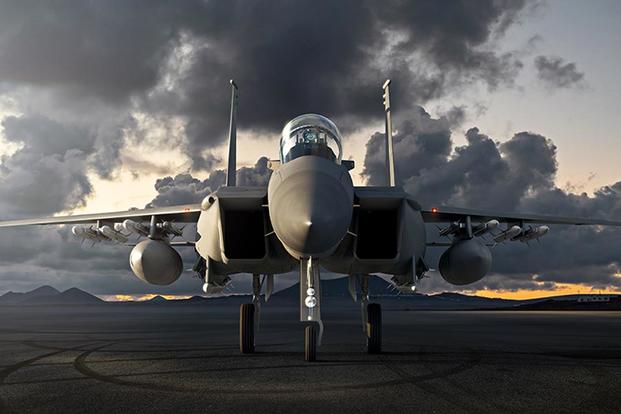ABOARD A C-37 MILITARY AIRCRAFT -- As Congress reviews the Defense Department's budget request for the upcoming fiscal year, the prospect of adding a new, fourth-generation fighter should be weighed against the necessity of growing the Air Force's inventory with more capable aircraft to replace the aging current fleet, according to the service's top civilian.
The only factor that would stifle the new F-15EX fleet would be another bad budget situation, said outgoing Air Force Secretary Heather Wilson.
"If the budget gets crunched in the out years, you can't start trading off and saying we're going to keep open an F-15 line for single-digit numbers of airplanes," Wilson said during an interview May 14. "This has to be a long-term commitment to get the Air Force [inventory] healthy."
If the budget does force the service to pick an aircraft, that decision is obvious, Wilson said. "We're not going to trade off fifth-generation for fourth-generation."
The goal is to keep a well-rounded mix of fourth- and fifth-generation aircraft through the 2030s. That includes the F-35A Joint Strike Fighter, F-16 Fighting Falcon, F-22 Raptor, A-10 Thunderbolt II and the F-15 Eagle/Strike Eagle, she said.
Related content:
- Pentagon Buying F-15EX Alongside F-35s to Preserve Diversity, Official Says
- Lawmakers Concerned Push for F-15X Is Reducing F-35 Procurement
- Air Force Secretary Wants Pilots to Get More Simulator Time
But "the F-15C is not going to make it," Wilson said during the interview. "We need to replace those F-15Cs with something."
Military.com traveled with the outgoing secretary on one of her last trips to Air University at Maxwell Air Force Base, Alabama, before she departs the Pentagon in the next two weeks to take her new position as president of the University of Texas at El Paso.
Officials in 2017 voiced the same concern about the F-15C's longevity.
The original plan to replace retiring F-15s with F-22 Raptors "was foreclosed. So we think this is a good option," Wilson said.
It has been more than 20 years since a new F-15 model was added to the Air Force's inventory.
During a speech Wilson made earlier at Maxwell to audiences attending a National Security Forum, the secretary cited concerns with the F-15C's longerons.
"We are already having serious problems with that airframe, with metal fatigue within the longerons on the side of the aircraft," she said during the forum.
In order to stop the average age its aircraft inventory from increasing, the service calculates it needs to buy 72 new aircraft per year to replace old planes, Wilson said.
In March, Wilson told reporters at the annual Air Force Association Air Warfare Symposium in Orlando, Florida, that the service needs to boost its fighter inventory, but had not expected to do so with the F-15EX.
But in the service's 2020 budget proposal to Congress, officials are requesting to buy 48 Lockheed Martin-made F-35A jets each year through 2024, as well as eight new "F-15EX" fighters. The service plans to buy 80 F-15s over the next five years, increasing its inventory to at least 144 over the next decade.
The F-15EX fighter jet proposal has been a subject of hot debate in Washington, D.C.
Last week, lawmakers signaled that the Boeing-made F-15EX is inching closer to reality with the release of the House Appropriations Committee's draft defense bill, which would fund eight of the aircraft.
Wilson's message to those on both sides of the F-15EX debate is simple: There needs to be a balance.
"You've got to, in some way, modernize here. I think the fear of the Air Force, before the F-35 got going, is that it would [meet] the same fate as the F-22. [But] we are now at a point with the F-35 where the price is coming down. We are doing everything that we can to drive down the cost of sustainment, to make this a long-term commitment. I hope we're at a point now where the commitment is high enough to recapitalize the Air Force with F-35s" over time, while attending to the F-15C dilemma, she said.
Ex-pilots have publicly criticized the F-15EX choice, saying it’s strategically dislocating to the overall mission.
"To me, this is a moral issue," said retired Gen. T. Michael "Buzz" Moseley, former Air Force chief of staff, in a recent interview with Military.com. "Do we put our young officers in an airplane that we know, before we even buy them, that they're not as survivable?"
The former chief and F-15 Eagle pilot said a smarter choice for the Air Force may have passed the service by.
"If the Air Force or [the Defense Department instead] three-to-four years ago had decided to build a derivative of the F-22 … that would have probably have been the right time," he said.
Moseley, who was removed as chief by then-Defense Secretary Bob Gates, was a fierce advocate of keeping to the original plan of buying 381 F-22s.
"I think that, by not looking to build an F-22 derivative a few years ago, the window of opportunity has probably closed," he said.
-- Oriana Pawlyk can be reached at oriana.pawlyk@military.com. Follow her on Twitter at @Oriana0214.













